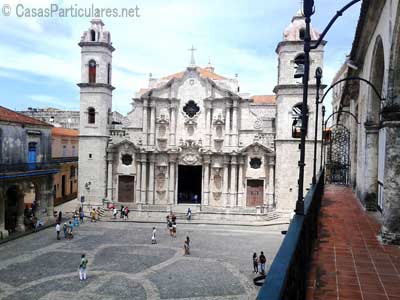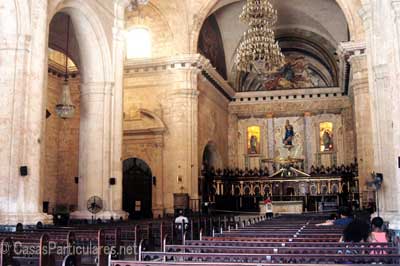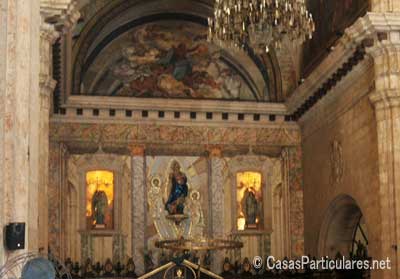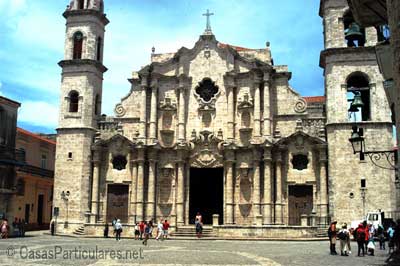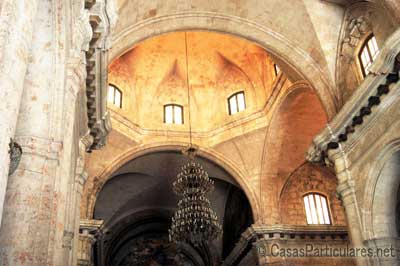The Cathedral of Havana
By Anonymous, translated from Spanish by Danil Ren.
The Cathedral We Admire
Old Havana seduces but not for being a metropolis (it isn't), but because of its simplicity and the historical value of its edifications and monuments. One of the most outstanding building is, without a doubt, the Cathedral of Old Havana, a temple located in the historical center of the capital of Cuba, as an architectonic that challenges time.
We know that the Cathedral was built to respond to an interest of Jesuits, it was initially built with the aim to become a Jesuit's seminary in 1748, but, just in 1777 it was finished thanks to the Felipe José de Tres Palacios bishop, who conceived it as a cathedral, after that in the country two other ecclesiastic seats were established, one in Santiago of Cuba and the other in Havana. Still, the name of the architect who took charge of the project is unknown.
A Baroque Cathedral in a Colonial Context
Conceived to show off a purely baroque style from the Tuscan school (because of its two asymmetric towers), several authors of architectonic literature of Havana refer that the cathedral was also under the neoclassic influence, which dominated during the XIX century. Then, the Cathedral was submitted to several changes in the inside, something that will occur again in two more occasions.
We say that during the 1940's the original roof was replaced by another made of stones and which simulates a vault. The church makes a perimeter of 34 square meters for 36 meters in length and it arranges a trio of three-piece of naves in both sides, which are divided by large pillars.
The Temple Inside
The Major Altar is the most noticeable element inside the Cathedral, where we can appreciate a resplendent image of the Virgin Mary of the Immaculate Conception and Blessed, to which the Cathedral itself was devoted since its foundation; in face of the altar, you can see standing sculptures and jewelry made in Rome in the first half of the XIX century.
The Loreto Chapelis also one of the standing elements, the only inheritance of the passage of the Jesuits in the capital of Cuba. We can also appreciate, in the side chapels, some good reproductions of baroque paints by Pedro Pablo Rubens and Bartolomé Esteban Murillo, oil painted by the French artist Jean-Baptiste Vermay.
In the upper side of the altar, we can appreciate three images by the Italian artist Giuseppe Perovani, among them the Assumption work; equally admirable is an original effigy of Saint Christopher, patron of Havana City and located in the side of the central nave.
Also, original from the XVIII century, we can see the Canons chorus drawing and the furnitures of the sacristy.
Inside the temple, we also find several crypts of bishops and illustrious figures of Havana. But the most curious fact that not everyone knows is that, during some time, the remaining of the admiral Christopher Columbus rested there, before to be transported to their final destination, the Cathedral of Seville, Spain.
Without a doubt, the most impressive thing about the Cathedral of Havana is its Façade, an irrefutable demonstration of the neoclassic baroque which dominates the entire place. Made completely by dark gray stones, experts ensure that it is about a changing façade, able to change its position according to the position of the observer, something we can especially appreciate from its cornice and, furthermore, we get surprised by the large variety of marine flora and fauna fossils (shells, carapaces, hedgehogs and so on), embedded in the wall.
The design of the façade, conceived by the Italian architect Fancesco Borromini, is a perfect contrast with the typical light of a tropical climate and it presents two bell towers which assume a total asymmetry, since one of the two towers is notably bigger than the other and it has two bells.
A colossal gate, a cross in the peak of the Cathedral and the towers, which also have the function of panoramic viewpoints, all this makes this temple a must visit place.
A Singular Temple
We have already said that one of the effigies inside the temple is devoted to Saint Christobal, one of the four protector saints of the city, patron of Havana, was converted into the Afro-Cuban orisha ggayú Solá, supreme defender of weaks. Therefore it's not strange to find several offerings in the Afro-Cuban yoruba religion.
Anyway this mix of religions will not prevent the Cathedral from be a place essentially catholic, but still its doors are kept open to the religious world in general and to all those wanting to enter the holy place, assuming that they respect the peace and quietness the devoted need inside that majestic edification.
The Cathedral and the Surroundings
The place containing the Cathedral and which is simply called The Plaza of the Cathedral, contains several others sites of interest such as: The Real Zanja, the Count Don Luís Chacón's House or simply Casa Bayona, the Marqis de Aguas Claras's Palace (currently it's the El Patio restaurant), the Palace or Maison of Comte de Lombillo (today Bureau of the Historiographre of Havane), and finally the Marquis d'Arcos's house.
Essential Data of the Cathedral and Final Considerations
The Cathedral is located in the place having the same name and, more precisely, Empedrado street nr. 156, open from Monday to Friday from 9 AM to 4:30 PM and Sunday (and festive days) from 9 AM to 12 PM; the entrance is free but if you want to get the wood stairs and visit the bell towers, you will probably have to pay a tariff.
The current vicar of the Cathedral of Havana, the father Yosvany Carvajal, offers archdioceses official ceremonies, masses, baptisms, marriages and other activities.
The temple also received illustrious figures of the Church, the culture and the politics, such as the Jean-Paul II pope in 1998 and the Francisco pope in 2015. A year after, the former US president, Barack Obama, visited the Cathedral with his family, when he visited Havana.
As a perpetual symbol of the Cuban capital, The Havana Cathedral was immortalized into centuries by several art tendencies and, 500 years after the foundation of Saint Christobal city (that is, the city of Havana), it continues to be a visual spectacle, a must visit.
To learn more about the other places located in the Cathedral Plaza, see the remaining of our Old Havana Essential and Definitive Guide.







